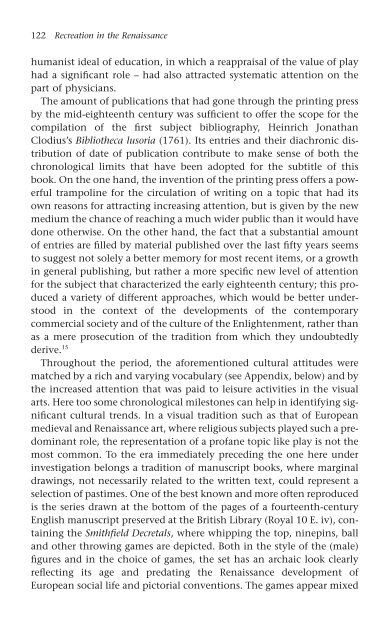Recreation in the Renaissance
Recreation in the Renaissance
Recreation in the Renaissance
- No tags were found...
Create successful ePaper yourself
Turn your PDF publications into a flip-book with our unique Google optimized e-Paper software.
122 <strong>Recreation</strong> <strong>in</strong> <strong>the</strong> <strong>Renaissance</strong><br />
humanist ideal of education, <strong>in</strong> which a reappraisal of <strong>the</strong> value of play<br />
had a significant role – had also attracted systematic attention on <strong>the</strong><br />
part of physicians.<br />
The amount of publications that had gone through <strong>the</strong> pr<strong>in</strong>t<strong>in</strong>g press<br />
by <strong>the</strong> mid-eighteenth century was sufficient to offer <strong>the</strong> scope for <strong>the</strong><br />
compilation of <strong>the</strong> first subject bibliography, He<strong>in</strong>rich Jonathan<br />
Clodius’s Biblio<strong>the</strong>ca lusoria (1761). Its entries and <strong>the</strong>ir diachronic distribution<br />
of date of publication contribute to make sense of both <strong>the</strong><br />
chronological limits that have been adopted for <strong>the</strong> subtitle of this<br />
book. On <strong>the</strong> one hand, <strong>the</strong> <strong>in</strong>vention of <strong>the</strong> pr<strong>in</strong>t<strong>in</strong>g press offers a powerful<br />
trampol<strong>in</strong>e for <strong>the</strong> circulation of writ<strong>in</strong>g on a topic that had its<br />
own reasons for attract<strong>in</strong>g <strong>in</strong>creas<strong>in</strong>g attention, but is given by <strong>the</strong> new<br />
medium <strong>the</strong> chance of reach<strong>in</strong>g a much wider public than it would have<br />
done o<strong>the</strong>rwise. On <strong>the</strong> o<strong>the</strong>r hand, <strong>the</strong> fact that a substantial amount<br />
of entries are filled by material published over <strong>the</strong> last fifty years seems<br />
to suggest not solely a better memory for most recent items, or a growth<br />
<strong>in</strong> general publish<strong>in</strong>g, but ra<strong>the</strong>r a more specific new level of attention<br />
for <strong>the</strong> subject that characterized <strong>the</strong> early eighteenth century; this produced<br />
a variety of different approaches, which would be better understood<br />
<strong>in</strong> <strong>the</strong> context of <strong>the</strong> developments of <strong>the</strong> contemporary<br />
commercial society and of <strong>the</strong> culture of <strong>the</strong> Enlightenment, ra<strong>the</strong>r than<br />
as a mere prosecution of <strong>the</strong> tradition from which <strong>the</strong>y undoubtedly<br />
derive. 15<br />
Throughout <strong>the</strong> period, <strong>the</strong> aforementioned cultural attitudes were<br />
matched by a rich and vary<strong>in</strong>g vocabulary (see Appendix, below) and by<br />
<strong>the</strong> <strong>in</strong>creased attention that was paid to leisure activities <strong>in</strong> <strong>the</strong> visual<br />
arts. Here too some chronological milestones can help <strong>in</strong> identify<strong>in</strong>g significant<br />
cultural trends. In a visual tradition such as that of European<br />
medieval and <strong>Renaissance</strong> art, where religious subjects played such a predom<strong>in</strong>ant<br />
role, <strong>the</strong> representation of a profane topic like play is not <strong>the</strong><br />
most common. To <strong>the</strong> era immediately preced<strong>in</strong>g <strong>the</strong> one here under<br />
<strong>in</strong>vestigation belongs a tradition of manuscript books, where marg<strong>in</strong>al<br />
draw<strong>in</strong>gs, not necessarily related to <strong>the</strong> written text, could represent a<br />
selection of pastimes. One of <strong>the</strong> best known and more often reproduced<br />
is <strong>the</strong> series drawn at <strong>the</strong> bottom of <strong>the</strong> pages of a fourteenth-century<br />
English manuscript preserved at <strong>the</strong> British Library (Royal 10 E. iv), conta<strong>in</strong><strong>in</strong>g<br />
<strong>the</strong> Smithfield Decretals, where whipp<strong>in</strong>g <strong>the</strong> top, n<strong>in</strong>ep<strong>in</strong>s, ball<br />
and o<strong>the</strong>r throw<strong>in</strong>g games are depicted. Both <strong>in</strong> <strong>the</strong> style of <strong>the</strong> (male)<br />
figures and <strong>in</strong> <strong>the</strong> choice of games, <strong>the</strong> set has an archaic look clearly<br />
reflect<strong>in</strong>g its age and predat<strong>in</strong>g <strong>the</strong> <strong>Renaissance</strong> development of<br />
European social life and pictorial conventions. The games appear mixed










